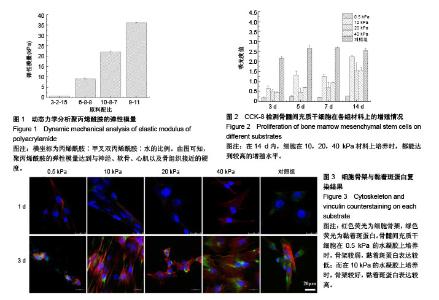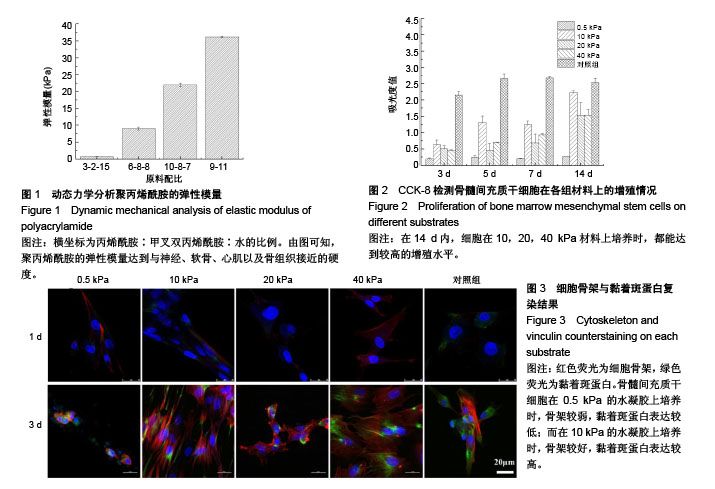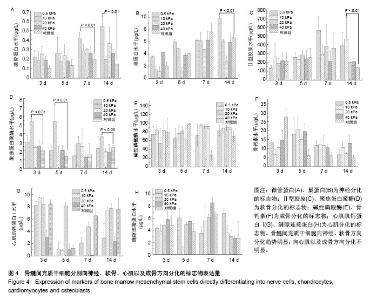Chinese Journal of Tissue Engineering Research ›› 2018, Vol. 22 ›› Issue (25): 3981-3986.doi: 10.3969/j.issn.2095-4344.0956
Previous Articles Next Articles
Directed differentiation of bone marrow mesenchymal stem cells under regulation by polyacrylamide with different stiffness
Guo Jiang-long, He Jing, Wu Fang
- National Engineering Research Center for Biomaterials, Sichuan University, Chengdu 610000, Sichuan Province, China
-
Revised:2018-05-29Online:2018-09-08Published:2018-09-08 -
Contact:Wu Fang, Researcher, National Engineering Research Center for Biomaterials, Sichuan University, Chengdu 610000, Sichuan Province, China; He Jing, Assistant researcher, National Engineering Research Center for Biomaterials, Sichuan University, Chengdu 610000, Sichuan Province, China -
About author:Guo Jiang-long, Master, National Engineering Research Center for Biomaterials, Sichuan University, Chengdu 610000, Sichuan Province, China -
Supported by:the National Natural Science Foundation of China, No. 81671826; the National Key Research and Development Research Program of China, No. 2016YFC1101903
CLC Number:
Cite this article
Guo Jiang-long, He Jing, Wu Fang. Directed differentiation of bone marrow mesenchymal stem cells under regulation by polyacrylamide with different stiffness[J]. Chinese Journal of Tissue Engineering Research, 2018, 22(25): 3981-3986.
share this article

2.1 动态力学分析弹性模量 通过动态力学分析的数据,可以发现最终聚丙烯酰胺的弹性模量与作者最初设计的弹性模量相近,实际的弹性模量分别为0.75,9,21,36 kPa,与神经组织、软骨组织、心肌组织和骨组织模量类似,见图1。 2.2 细胞增殖结果 细胞在弹性模量10,20,40 kPa的材料上培养时,细胞数量随着时间的增加而增加,而细胞在弹性模量0.5 kPa的材料上培养时,细胞数量始终处于较低的水平。总体来看,细胞的增殖结果为10 kPa>40 kPa>20 kPa>0.5 kPa,见图2。 2.3 细胞骨架与黏着斑蛋白复染结果 细胞在材料上第1天时,总体来看都偏弱,细胞在弹性模量0.5,10,40 kPa的材料上培养时,相对于20 kPa与对照组,骨架较为明显,这说明在第1天时细胞铺展不完全。 从鬼笔环肽的染色结果来看,第3天时细胞在弹性模量10 kPa与40 kPa的材料上培养时,细胞骨架较为清晰,细胞在弹性模量20 kPa和0.5 kPa的材料上培养时,骨架较弱,且细胞形态呈圆形。从细胞骨架的清晰程度来看,10 kPa>40 kPa>对照组>20 kPa>0.5 kPa。 从黏着斑蛋白的染色结果看,细胞在弹性模量40 kPa的材料上培养时,黏着斑蛋白的表达量最高。细胞在弹性模量20 kPa的材料上培养时,虽然骨架形态较弱,但是黏着斑蛋白的表达呈现较高的水平。在弹性模量10 kPa的材料上培养时,虽然细胞骨架最为清晰,但是黏着斑蛋白的表达量较低。细胞在弹性模量0.5 kPa的材料上培养时,黏着斑蛋白的表达量最低。总体来看,黏着斑蛋白的表达量为:对照组>40 kPa>20 kPa>10 kPa>0.5 kPa,见图3。 2.4 细胞分化相关标志物表达 微管蛋白、巢蛋白是神经细胞分化晚期的标志物。Ⅱ型胶原与聚焦蛋白聚糖广泛存在于软骨细胞外基质中,是软骨细胞分化的标志物。缝隙连接蛋白是一种表达在心肌细胞中的跨膜蛋白;心肌肌钙蛋白I存在于心肌细胞胞浆中,是心肌细胞分化的标志物。骨钙素在骨钙代谢调节中起重要作用;碱性磷酸酶是骨组织中合成的一类功能性酶,是成骨分化的标志物,见图4。 BMSCs在0.5 kPa的基底上培养时,随着培养天数的增加,神经分化相关蛋白微管蛋白、巢蛋白的表达量增多,巢蛋白的表达量在第14天时明显高于其他组,微管蛋白的表达量在第7天和第14天明显高于其他组的基底材料。 BMSCs在0.5 kPa与10 kPa的基底上培养时,软骨分化标志物Ⅱ型胶原的表达量在第14天时要显著高于其他组,而聚焦蛋白聚糖的表达量在10 kPa的基底上较高,尤其是在第3天与第5天时,表达量远高于其他组。 成骨分化的标志物碱性磷酸酶和骨钙素的表达量在4组基底上没有表现出明显的差别。 心肌细胞分化的特征蛋白缝隙连接蛋白和心肌肌钙蛋白I的表达,虽然在各组之间存在一定的差别,但无明显规律。"

| [1] Guilak F, Cohen DM, Estes BT, et al. Control of stem cell fate by physical interactions with the extracellular matrix.Cell Stem Cell. 2009;5(1):17-26.[2] Takahashi I, Masuda T, Kohsaka K, et al. Molecular Mechanisms of Mechanical Stress Response during Chondrogenesis. J Biome Sci Eng.2009;4(3):307-317.[3] Angele P, Yoo JU, Smith C, et al. Cyclic hydrostatic pressure enhances the chondrogenic phenotype of human mesenchymal progenitor cells differentiated in vitro.J Orthop Res. 2003;21(3):451-457.[4] 彭小玲. 弹性基底力学性能测量及其调控细胞粘附的机制研究[D]. 北京:北京大学, 2012.[5] Dado D, Sagi M, Levenberg S, et al. Mechanical control of stem cell differentiation.Regen Med. 2012;7(1):101-116.[6] Daley WP, Peters SB, Larsen M.Extracellular matrix dynamics in development and regenerative medicine.J Cell Sci. 2008; 121(Pt 3):255-264.[7] Engler AJ, Sen S, Sweeney HL, et al. Matrix elasticity directs stem cell lineage specification.Cell. 2006;126(4):677-689.[8] Oh SH, An DB, Kim TH, et al. Wide-range stiffness gradient PVA/HA hydrogel to investigate stem cell differentiation behavior. ActaBiomater. 2016;35:23-31.[9] Wang LS, Du C, Chung JE, et al. Enzymatically cross-linked gelatin-phenol hydrogels with a broader stiffness range for osteogenic differentiation of human mesenchymal stem cells. ActaBiomater. 2012;8(5):1826-1837.[10] McAndrews KM, Kim MJ, Lam TY,et al.Architectural and mechanical cues direct mesenchymal stem cell interactions with crosslinked gelatin scaffolds.Tissue Eng Part A. 2014; 20(23-24):3252-3260.[11] Seib FP, Prewitz M, Werner C, et al. Matrix elasticity regulates the secretory profile of human bone marrow-derived multipotentmesenchymal stromal cells (MSCs). Biochem Biophys Res Commun. 2009;389(4):663-667.[12] Kwon HJ, Yasuda K.Chondrogenesis on sulfonate-coated hydrogels is regulated by their mechanical properties.J MechBehav Biomed Mater. 2013;17:337-346.[13] Cameron AR, Frith JE, Cooper-White JJ.The influence of substrate creep on mesenchymal stem cell behaviour and phenotype.Biomaterials. 2011;32(26):5979-5993.[14] Murphy CM, Matsiko A, Haugh MG, et al. Mesenchymal stem cell fate is regulated by the composition and mechanical properties of collagen-glycosaminoglycan scaffolds.J MechBehav Biomed Mater. 2012;11:53-62.[15] Du J, Chen X, Liang X, et al. Integrin activation and internalization on soft ECM as a mechanism of induction of stem cell differentiation by ECM elasticity.ProcNatlAcadSci U S A. 2011;108(23):9466-9471.[16] Shih YR, Tseng KF, Lai HY, et al. Matrix stiffness regulation of integrin-mediated mechanotransduction during osteogenic differentiation of human mesenchymal stem cells.J Bone Miner Res. 2011;26(4):730-738.[17] McBeath R, Pirone DM, Nelson CM, et al. Cell shape, cytoskeletal tension, and RhoA regulate stem cell lineage commitment.Dev Cell. 2004;6(4):483-495.[18] Geiger B, Bershadsky A, Pankov R, et al. Transmembrane crosstalk between the extracellular matrix--cytoskeleton crosstalk.Nat Rev Mol Cell Biol. 2001;2(11):793-805.[19] Gingras AR, Ziegler WH, Frank R, et al. Mapping and consensus sequence identification for multiple vinculin binding sites within the talin rod.J Biol Chem. 2005;280(44): 37217-37224.[20] Xing B, Jedsadayanmata A, Lam SC.Localization of an integrin binding site to the C terminus of talin.J Biol Chem. 2001;276 (48):44373-44378.[21] Ulmer TS, Calderwood DA, Ginsberg MH, et al. Domain-specific interactions of talin with the membrane-proximal region of the integrin beta3 subunit. Biochemistry. 2003;42(27):8307-8312.[22] Vogel V, Sheetz MP.Cell fate regulation by coupling mechanical cycles to biochemical signaling pathways.CurrOpin Cell Biol. 2009;21(1):38-46.[23] Wang PY, Tsai WB, Voelcker NH.Screening of rat mesenchymal stem cell behaviour on polydimethylsiloxane stiffness gradients.ActaBiomater. 2012;8(2):519-530.[24] Mao AS, Shin JW, Mooney DJ.Effects of substrate stiffness and cell-cell contact on mesenchymal stem cell differentiation. Biomaterials. 2016;98:184-191.[25] Park JS, Chu JS, Tsou AD, et al. The effect of matrix stiffness on the differentiation of mesenchymal stem cells in response to TGF-β.Biomaterials. 2011;32(16):3921-3930.[26] Wang LS, Boulaire J, Chan PP, et al. The role of stiffness of gelatin-hydroxyphenylpropionic acid hydrogels formed by enzyme-mediated crosslinking on the differentiation of human mesenchymal stem cell.Biomaterials. 2010;31(33):8608-8616.[27] Zhang X, Jaramillo M, Singh S, et al. Analysis of regulatory network involved in mechanical induction of embryonic stem cell differentiation.PLoS One. 2012;7(4):e35700.[28] Evans ND, Minelli C, Gentleman E, et al. Substrate stiffness affects early differentiation events in embryonic stem cells.Eur Cell Mater. 2009;18:1-13.[29] Kraehenbuehl TP, Zammaretti P, Van der Vlies AJ, et al. Three-dimensional extracellular matrix-directed cardioprogenitor differentiation: systematic modulation of a synthetic cell-responsive PEG-hydrogel.Biomaterials. 2008; 29(18):2757-2766.[30] Li Z, Guo X, Palmer AF, et al. High-efficiency matrix modulus- induced cardiac differentiation of human mesenchymal stem cells inside a thermosensitive hydrogel.ActaBiomater. 2012; 8(10):3586-3595.[31] Gershlak JR, Resnikoff JI, Sullivan KE, et al. Mesenchymal stem cells ability to generate traction stress in response to substrate stiffness is modulated by the changing extracellular matrix composition of the heart during development. Biochem Biophys Res Commun. 2013;439(2):161-166.[32] Puklin-Faucher E, Sheetz MP.The mechanical integrin cycle.J Cell Sci. 2009;122(Pt 2):179-186.[33] Dupont S, Morsut L, Aragona M, et al. Role of YAP/TAZ in mechanotransduction.Nature. 2011;474(7350):179-183.[34] Yang C, Zeisberg M, Mosterman B, et al. Liver fibrosis: insights into migration of hepatic stellate cells in response to extracellular matrix and growth factors.Gastroenterology. 2003;124(1):147-159.[35] Li YY, Choy TH, Ho FC, et al. Scaffold composition affects cytoskeleton organization, cell-matrix interaction and the cellular fate of human mesenchymal stem cells upon chondrogenic differentiation.Biomaterials. 2015;52:208-220.[36] Carisey A, Ballestrem C.Vinculin, an adapter protein in control of cell adhesion signalling.Eur J Cell Biol. 2011;90(2-3): 157-163. |
| [1] | Pu Rui, Chen Ziyang, Yuan Lingyan. Characteristics and effects of exosomes from different cell sources in cardioprotection [J]. Chinese Journal of Tissue Engineering Research, 2021, 25(在线): 1-. |
| [2] | Lin Qingfan, Xie Yixin, Chen Wanqing, Ye Zhenzhong, Chen Youfang. Human placenta-derived mesenchymal stem cell conditioned medium can upregulate BeWo cell viability and zonula occludens expression under hypoxia [J]. Chinese Journal of Tissue Engineering Research, 2021, 25(在线): 4970-4975. |
| [3] | Zhang Tongtong, Wang Zhonghua, Wen Jie, Song Yuxin, Liu Lin. Application of three-dimensional printing model in surgical resection and reconstruction of cervical tumor [J]. Chinese Journal of Tissue Engineering Research, 2021, 25(9): 1335-1339. |
| [4] | Hou Jingying, Yu Menglei, Guo Tianzhu, Long Huibao, Wu Hao. Hypoxia preconditioning promotes bone marrow mesenchymal stem cells survival and vascularization through the activation of HIF-1α/MALAT1/VEGFA pathway [J]. Chinese Journal of Tissue Engineering Research, 2021, 25(7): 985-990. |
| [5] | Shi Yangyang, Qin Yingfei, Wu Fuling, He Xiao, Zhang Xuejing. Pretreatment of placental mesenchymal stem cells to prevent bronchiolitis in mice [J]. Chinese Journal of Tissue Engineering Research, 2021, 25(7): 991-995. |
| [6] | Liang Xueqi, Guo Lijiao, Chen Hejie, Wu Jie, Sun Yaqi, Xing Zhikun, Zou Hailiang, Chen Xueling, Wu Xiangwei. Alveolar echinococcosis protoscolices inhibits the differentiation of bone marrow mesenchymal stem cells into fibroblasts [J]. Chinese Journal of Tissue Engineering Research, 2021, 25(7): 996-1001. |
| [7] | Fan Quanbao, Luo Huina, Wang Bingyun, Chen Shengfeng, Cui Lianxu, Jiang Wenkang, Zhao Mingming, Wang Jingjing, Luo Dongzhang, Chen Zhisheng, Bai Yinshan, Liu Canying, Zhang Hui. Biological characteristics of canine adipose-derived mesenchymal stem cells cultured in hypoxia [J]. Chinese Journal of Tissue Engineering Research, 2021, 25(7): 1002-1007. |
| [8] | Geng Yao, Yin Zhiliang, Li Xingping, Xiao Dongqin, Hou Weiguang. Role of hsa-miRNA-223-3p in regulating osteogenic differentiation of human bone marrow mesenchymal stem cells [J]. Chinese Journal of Tissue Engineering Research, 2021, 25(7): 1008-1013. |
| [9] | Lun Zhigang, Jin Jing, Wang Tianyan, Li Aimin. Effect of peroxiredoxin 6 on proliferation and differentiation of bone marrow mesenchymal stem cells into neural lineage in vitro [J]. Chinese Journal of Tissue Engineering Research, 2021, 25(7): 1014-1018. |
| [10] | Zhu Xuefen, Huang Cheng, Ding Jian, Dai Yongping, Liu Yuanbing, Le Lixiang, Wang Liangliang, Yang Jiandong. Mechanism of bone marrow mesenchymal stem cells differentiation into functional neurons induced by glial cell line derived neurotrophic factor [J]. Chinese Journal of Tissue Engineering Research, 2021, 25(7): 1019-1025. |
| [11] | Duan Liyun, Cao Xiaocang. Human placenta mesenchymal stem cells-derived extracellular vesicles regulate collagen deposition in intestinal mucosa of mice with colitis [J]. Chinese Journal of Tissue Engineering Research, 2021, 25(7): 1026-1031. |
| [12] | Pei Lili, Sun Guicai, Wang Di. Salvianolic acid B inhibits oxidative damage of bone marrow mesenchymal stem cells and promotes differentiation into cardiomyocytes [J]. Chinese Journal of Tissue Engineering Research, 2021, 25(7): 1032-1036. |
| [13] | Li Cai, Zhao Ting, Tan Ge, Zheng Yulin, Zhang Ruonan, Wu Yan, Tang Junming. Platelet-derived growth factor-BB promotes proliferation, differentiation and migration of skeletal muscle myoblast [J]. Chinese Journal of Tissue Engineering Research, 2021, 25(7): 1050-1055. |
| [14] | Wang Xianyao, Guan Yalin, Liu Zhongshan. Strategies for improving the therapeutic efficacy of mesenchymal stem cells in the treatment of nonhealing wounds [J]. Chinese Journal of Tissue Engineering Research, 2021, 25(7): 1081-1087. |
| [15] | Wang Shiqi, Zhang Jinsheng. Effects of Chinese medicine on proliferation, differentiation and aging of bone marrow mesenchymal stem cells regulating ischemia-hypoxia microenvironment [J]. Chinese Journal of Tissue Engineering Research, 2021, 25(7): 1129-1134. |
| Viewed | ||||||
|
Full text |
|
|||||
|
Abstract |
|
|||||

